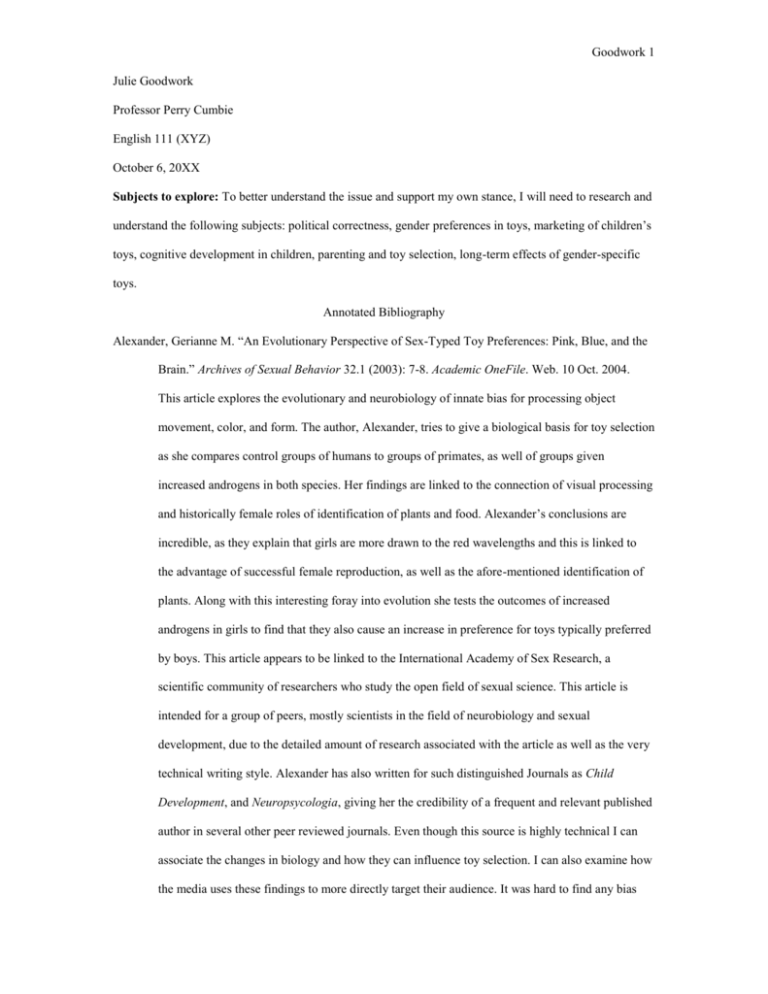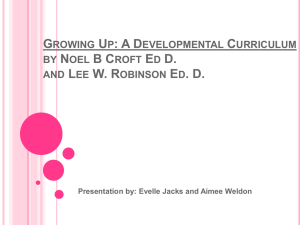sample annotated bibliography
advertisement

Goodwork 1 Julie Goodwork Professor Perry Cumbie English 111 (XYZ) October 6, 20XX Subjects to explore: To better understand the issue and support my own stance, I will need to research and understand the following subjects: political correctness, gender preferences in toys, marketing of children’s toys, cognitive development in children, parenting and toy selection, long-term effects of gender-specific toys. Annotated Bibliography Alexander, Gerianne M. “An Evolutionary Perspective of Sex-Typed Toy Preferences: Pink, Blue, and the Brain.” Archives of Sexual Behavior 32.1 (2003): 7-8. Academic OneFile. Web. 10 Oct. 2004. This article explores the evolutionary and neurobiology of innate bias for processing object movement, color, and form. The author, Alexander, tries to give a biological basis for toy selection as she compares control groups of humans to groups of primates, as well of groups given increased androgens in both species. Her findings are linked to the connection of visual processing and historically female roles of identification of plants and food. Alexander’s conclusions are incredible, as they explain that girls are more drawn to the red wavelengths and this is linked to the advantage of successful female reproduction, as well as the afore-mentioned identification of plants. Along with this interesting foray into evolution she tests the outcomes of increased androgens in girls to find that they also cause an increase in preference for toys typically preferred by boys. This article appears to be linked to the International Academy of Sex Research, a scientific community of researchers who study the open field of sexual science. This article is intended for a group of peers, mostly scientists in the field of neurobiology and sexual development, due to the detailed amount of research associated with the article as well as the very technical writing style. Alexander has also written for such distinguished Journals as Child Development, and Neuropsycologia, giving her the credibility of a frequent and relevant published author in several other peer reviewed journals. Even though this source is highly technical I can associate the changes in biology and how they can influence toy selection. I can also examine how the media uses these findings to more directly target their audience. It was hard to find any bias Goodwork 2 since she backs up almost every claim and variable by research data. There are seven pages of references associated with this article and they all seem to be from reputable journals of child psychology, development, and medical backgrounds. Gerianne M. Alexander holds a Ph.D and works in the Department of Psychology at Texas A&M University. Benezra, Karen. “Toy Unfair: There’s an Unending Variety of Toys for Boys, but Marketers Haven’t Gotten beyond Barbie and Baubles for Girls.” Brandweek 5 Nov. 1995: 20-26. Expanded Academic ASAP. Web. 15 Oct. 2004. Karen Benezra has written an article about the differences in toy choices and how the market is broken down by sales for certain gender-biased toys. This article talks about the gender gap, the way women toy inventors would like to see it change, and how such a thing came to be. It gives interesting viewpoints about the changes in toy preferences as the child ages. She says “2 and 3 year-olds both enjoy dolls, trucks, and kitchens…But at age 4…Boys opt for fast, action-oriented toys, while girls gravitate to nurturing and role play.” She also discusses approaches to dissect the older child’s toy market—something previous articles did not highlight. She goes into the videogame aisle and tries to figure out why there is such a low percentage of girls playing these games. This article is accessible from an online journal geared to advertising and the marketing association. I did not find them linked to a toy company as a parent company so I feel that this article probably showed little bias in the way of selecting one toymaker’s efforts over another. Karen Benezra, since the time of this article’s publication, has risen in the Brandweek’s organization to become the editor, and her predecessor became the editor for Businessweek. This source will help me transition to explaining the different age groups and toys that are geared for them. This is an excellent source to understand exact percentages of how much is spent on girls’, gender-neutral and boys’ toys, as well as giving great quotes to weave into my main body paragraphs to substantiate the claims that toys are marketed to certain genders. The statistics the article comes up with are not linked to a specific study so it is very hard to understand where the numbers come from. I will have to do more research as to where the company gets its statistical information. Cherney, Isabelle D., et al. “The Effects of Stereotyped Toys and Gender on Play Assessment in Children Aged 18-47 Months.” Educational Psychology 23.1 (2003): 95-106. ERIC. Web. 6 Oct. 2004. This article, written under the sponsorship of Creighton University and the University of Goodwork 3 Nebraska, examines the effect of gender toys in play situations. This lengthy article is spellbinding, as they fully outline and discuss the parameters of their study. There is complete yet concise information about the toys, subjects, and internal desires the subjects (children) might have for the selected toys. It includes graphs for the differences in mean time per play session with the gender neutral or gender-specific toy. As the authors stated, “one of our main goals was to assess whether the gender stereotype of a toy would influence the children’s play behaviors.” This statement coincides with other sources as the children’s play leads to conscious development. This is also one of the reasons it can also be used as an assessment tool for cognitive development. This article was first included in the journal published by Carfax Publishing titled Educational Psychology. This journal is devoted to publishing research of applied research in the fields of educational psychology. The subscriber to such a journal might include school counselors, pediatricians, and child psychologists to help them better diagnose and apply new methods with their own groups of children. The source is highly credible. The publisher supplies over 50 journals in the educational and medical field. The lead author, Dr. Isabelle Cherney, is recognized by Creighton University as a leader in the theory of play assessment and it seems she can speak fluently in five languages. This source could form a great foundation for my research paper. I could identify my own limits incorporating the ideas of defining which toys are gender-specific, and what are considered neutral. This source can also be used to wrap up my paper with the distinction between the high levels of play and how influential the toys are. Osterheldt, Jeneé. “Bending Traditional Gender Roles Starts in the Toy Aisle.” The Kansas City Star 23 June 2003. Newspaper source. Web. 29 Sept. 2004. Jeneé Osterheldt wrote a brief article for the Kansas City Star, a local newspaper, on the changes parents are seeing in the toy market and what it means for them and their children. She interviewed one woman of 31 years, reporting that this woman when she was a little girl wanted a “race track” for Christmas but in response her mother replied, “that’s a boy toy.” The author goes on to interview Michael Shore, a psychologist for Mattel, on how the toy industry is trying to design building toys specifically for girls and hopefully motivate girls to pursue fields of work that show a deficit of interest from the female gender. The author goes on to explain other developments in trying to bridge the gap between girls and boys and their interests in building. This source is an article from a printed newspaper, and it Goodwork 4 is significant because it addresses a specific toy maker’s attempts to address what they acknowledge as a problem and how they propose to turn the tide. Written for the general audience, it gives brief and interesting sources the reporter gathered to get a rounded view of the issue of girls and how toys are changing for them since their mothers’ time. The author has credibility, as the paper and newspaper seems to be a general local newspaper reporting the news instead of pushing any political agenda. This source is a great example of leading toymakers acknowledging the significance toys have in children’s roles and the steps they are taking to correct the situation. This source is very brief and not in-depth. If the story focused more on the toymakers’ view of the problem it would give it more authority than the interviews of a single mother or two. Some missing information is whether the situation is similar for boys and how the toy industry is resolving that issue as well. Shapiro, Lisa M. “Where Little Boys Can Play with Nail Polish.” Newsweek 28 May 1990: 62. Academic Search Complete. Web. 6 Oct. 2004. This article is an interview with a manager of a child research department at Fisher Price, a leading toy manufacturer. The manager, Kathleen Alfano, talks about how children will go to any toy until they reach the magical age of three or four, then they will choose gender-specific toys. She goes on to say: “You see it in the stores. Toys for children 5 and up will be in either the girls’ aisles or the boys’ aisles.” She goes on to talk about Fisher Price’s own push in the open gender toy market and how Fisher Price has found that they have not been successful. Recently at the “play lab” they had a surprising afternoon where a bottle of nail polish was left out for boys and girls and after the girls were finished painting their nails the boys painted their nails. They often set out for toys to be gender-neutral only to have parents only buy it for boys and vice versa. This article was written for Newsweek, a general audience magazine, with no academic drive to it. This is an interesting article for the fact that their foray into the gender-neutral toy world went bust; rather strange in a world working for equality. Since the database did not list the first name of the author it is impossible to search for the credibility of this source in term of author. I will say that it is a widely circulated magazine with a large subscriber base, so there must be some system of checks and balances to find the accuracy of the article. I will probably not use the article for its lack of validated information and brevity.








